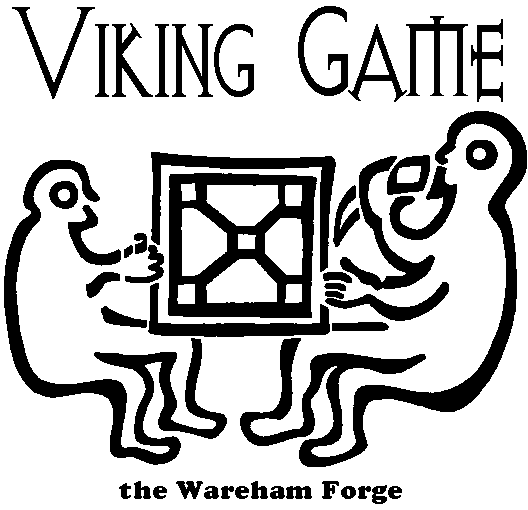
This
page offers additional information about VIKING GAME an exciting re-creation
of the old Viking game of Hnefatafl.
The Starting Layout
Back to top
Hints and Strategies
-
The King is a very powerful
piece! The Defender can move him into situations that would be dangerous
for other men, and use him as an anvil to kill the attackers. The Attacker
should try to keep the king pinned into the centre part of the board, if
he gets loose the Defender has a large advantage.
-
The rows and columns one
away from the outside edge are very powerful. If the king gets in
this position when there are no other pieces in it, this becomes an automatic
win. Both sides should watch for this.
-
Always remember that any
piece can move from one side of the board to the other in a single move.
Keep the big picture in mind at all times.
-
The attacker must be aggressive.
It is tempting to place 8 pieces beside the corner squares thus stopping
the King from escaping. This leaves your position much weaker with
only 16 attackers to the 13 defenders one of which is the very powerful
King. The time you need to block the corners will also give the defender
time to get the king in motion.
-
Diagonal lines are very
powerful tools. If the attacker can establish a line across a corner
of the board the pieces in the line cannot be killed (no defender can get
behind them). This line can be used to sweep the King into a trap.
Back to top
Alternate Rules
-
King only needs to get
to the side to win - not to a corner.
-
Add warnings "Check" and
"Mate". The Swedes used "Raichi" when the king was in danger or had
one way to win. They also used "Tuichi" when the king had two ways
to win (hence Mate).
-
Only use two men to kill
the king. If you use this rule then add a rule that the king can
only be killed if he cannot win with his next move.
-
Once the attacker has one
man on either side of the king, the king is dead unless he has a clear
path to the corner / side (depending on whether you are using alternate
rule 1 or not).
-
The Throne and Corners
count as "the other man". If you use this rule a piece may be captured
by being trapped between the throne and a piece of the opposite colour.
-
Let an attacker/ defender
move into the space between two opposing pieces without being 'killed'.
Back to top
Alternate starting positions
Back to top
Some interesting Henfatafl Links
Sten Helmfrid has a
version of the rules.
Ravensgard
maintains a page on Norse
Games.
Mistress
Gunnora of the SCA has a page
about her interpretation.
Infomation on other
Medieval games.
Medieval & Renaissance
Games Home Page.
Michael Roger's is
working on a version.
A modern interpretation.
Regia
maintains a page about viking
games.
Susan Granquist has
this interpretation.
Gamecabinet has a page.
gweboell
is a variant on the same game.
Back to top
Historical Background
Hnefatafl has been known in many forms and countries for many years. Currently the majority of our information on the rules of play comes from a record made by Carl Linneaus in 1732 when he was visiting the Lapps. He recorded a version of this game being played there which the local people claimed they had always played. This information is supplemented by manuscript Oxon 122 held at Corpus Christi College, which was written c. 925 AD. This manuscript records a 19x19 version of the game (called Alea Evangelii) and explains the moves and starting positions in terms of their religious significance.
There are six archaeological finds from the Viking Age of game boards (or parts of boards). These boards were found in the Faroes Islands at Toftanes (a 13x13 board dated to the tenth century); Ballinderry, Ireland (a 7x7 board from the late ninth century); Trondheim, Norway (an 11x11 board dated to the early twelfth century); Wimose (19x19? board dated to the Roman Age); Gokstad (an 13x13
dated to the late ninth century); and at Coppergate in York, England (15x15? or 19x19? Dated to the tenth century).
Game pieces are found in a wide range of sites and are made from stone, glass, ivory, bone, antler, amber, and bronze. Currently we know of 129 pieces dating from the eighth century through to the twelfth century.
This game was so prevalent that its use is even record on memorial stones - like the one at Ockello, Sweden from with the drawing on the game bag comes.
Casting the King Piece
The king piece is made
of modern 'lead free' pewter, which is a safe, high tin alloy. It has been
made using a hand cut soapsone mold - the same method that was used by
Viking Age craftsmen. The figure is based on a small bronze depiction
of the god Thor, from an artifact found in Iceland which dated to the 10th
century.
For more information
on our reconstruction and more detailed historical information see the
Hnefatafl Paper.
Back to top

